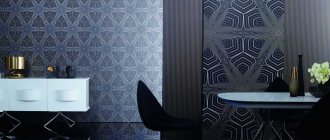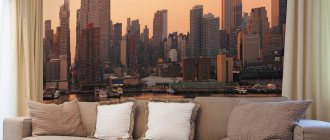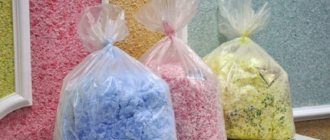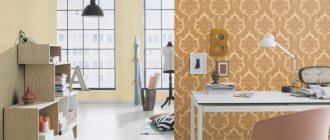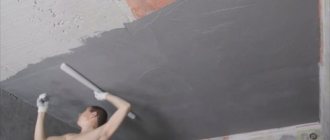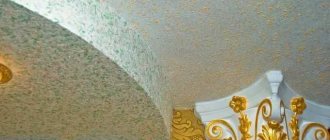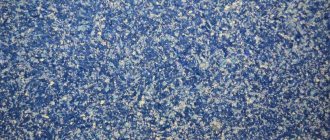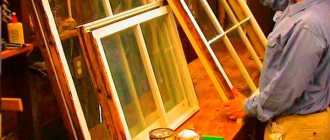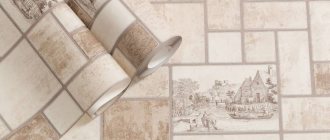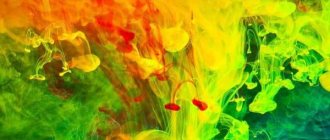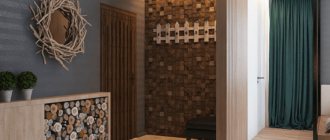What are the advantages of non-woven wallpaper?
Non-woven fabric - it was he who gave the name to a whole group of materials that differ in structure, density, relief and composition. Non-woven wallpaper is a semi-synthetic material based on natural cellulose. Unlike paper or fabric base, non-woven wallpaper base has a number of advantages:
- This is a very thin base.
- During the wetting process, the non-woven fabric does not stretch or deform.
- fabric is vapor-proof and breathable .
- Old non-woven wallpaper can be easily removed from the walls.
- The service life of non-woven wallpaper is 3-5 times longer than the service life of traditional paper wallpaper.
Why do non-woven wallpapers have many advantages?
Non-woven polypropylene consisting of cellulose fibers joined together using adhesives or by extrusion. Thanks to manufacturing technology, non-woven wallpaper contains much less chemicals than conventional paper wallpaper.
The surface of the non-woven backing can be attached to any material: paper, vinyl, fabric, bamboo or cork. Most non-woven wallpaper has a paper coating of varying degrees of grain and is intended for painting with water-dispersion paints. After drying, the paint can be washed or repainted 2-3 times in a row. Fully non-woven wallpaper is quite thick and heavy. They are easily recognized by the small shiny cellulose fibers on the outer surface of the canvas. They usually have a smooth surface and are used under paint.
More interesting: Paper for scrapbooking
General rules
Pasting new wallpaper without removing the old ones is very simple; you can do it yourself, but then there is the possibility of unpleasant surprises:
- “reluctance” of fresh wallpaper to stick to the wall - the surface bubbles or new wallpaper comes off along with a layer of old ones;
- the sloppy appearance of the surface - the inner finishing layer shines through the newly created one, or, what is even more unpleasant, paint from the old wallpaper seeps to the top.
There is no proven recipe for dealing with the first problem, but there are a number of recommendations:
- First make sure that the original layer of wallpaper is strong and free of defects - if it is uneven, peels off in places, has dents or bubbles, then another sheet pasted on top will only worsen the situation;
- It is not advisable to glue any wallpaper over a relief coating; the old wallpaper will most likely remain, but the new ones will not hold tightly, the same applies to non-woven or vinyl wallpaper without relief - their outer surface simply will not absorb the glue;
- You should not try to renew a wall covered with thick wallpaper; most often this measure speeds up the process of both layers peeling off.
How to glue vinyl wallpaper on non-woven backing
Now you can understand that gluing wallpaper onto non-woven wallpaper hardly makes sense. Even if high-quality glue was used for the first layer, you can and should, after making cuts on them, soak the wallpaper, remove it and prepare the wall properly.
However, you can do otherwise if we are talking about wallpaper on a non-woven basis, then it is considered acceptable to leave the non-woven material, removing only the vinyl layer. But it is advisable to glue wallpaper of a similar type onto it (non-woven or vinyl-non-woven).
Preparing walls for pasting non-woven wallpaper
If you do not want to lose all the qualities of the wallpaper, then before gluing non-woven wallpaper you need to prepare the walls well. Firstly, over the years of use, old wallpaper absorbs many chemicals from the surrounding air, including allergens contained in house dust.
Secondly, old paper wallpaper may have defects - tears, abrasions, dirt from grease and dried drops of paint. All this will inevitably affect you when you start gluing a new coating over these defects. This especially applies to thin non-woven wallpaper, which will repeat the relief of old wallpaper.
The third danger is the swelling of layers of old wallpaper , soaked from the action of glue on new wallpaper. This defect cannot be eliminated and the newly pasted wallpaper may simply move away from the wall along with the old ones.
The fourth disadvantage is that you deprive yourself of the main advantage of non-woven wallpaper - vapor and air permeability . The more layers of old wallpaper you have on your wall, especially heavy and old ones, the stronger the stale air in the apartment will be with the smell of wet paper.
So is it possible to glue wallpaper over old ones?
Of course, if you don’t waste your time peeling off the outdated wallpaper and leveling the walls, the result will be much faster, but it will be ugly and of poor quality. In addition, after some time, your new wallpaper will begin to bubble or, worse, fall off along with the old one. Therefore, answering the question whether it is possible to glue purchased wallpaper over old ones, a negative answer suggests itself. In addition, the top layer is removed very simply: after a little effort, only the non-woven base remains, onto which other materials can be glued. When renovating premises, it is allowed to paste only on a paper web where there is no obvious convex pattern.
Wallpapering can only be done on wallpaper without raised patterns.
Most often, the idea of gluing a new canvas on top of the old one comes when it is not possible to remove the existing layer from the walls, or simply without sufficient knowledge in this area. In order to correct this situation, it is necessary to make cuts on the old canvas using a regular stationery knife, and then moisten it generously with warm soapy water. For greater effect, this operation can be performed several times, after which the old wallpaper can be removed much easier.
Related article: What spider web tulle looks like on windows
Some craftsmen manage to hang wallpaper without preparing the walls, straight to whitewash, which is also not recommended. First you need to clean the whitewash from the ceiling or wall, apply a primer and only then glue it.
The picture is similar with wallpapering painted walls, since wallpaper glue is not absorbed by paint, especially water-based paint. If you nevertheless glued finishing material over whitewashed or painted surfaces, the work done will soon make you upset: the wallpaper will peel off by itself.
But gluing new ones onto drywall is very good! Since drywall is the same paper, only compressed, it tends to adhere well to similar material. The surface must be leveled and primed before gluing. With the right wallpapering technology, your walls will look perfect.
How to glue non-woven wallpaper onto plaster?
Gluing non-woven wallpaper onto plaster is the most common method of installing it. It is important to level the plaster with sandpaper or an abrasive mesh on a block before pasting. After this, the surface of the plaster must be treated with finishing putty. If you are using fine-grained plaster, you can do without finishing putty. After sanding, you need to sweep the walls with a brush to remove fine construction dust and prime the walls with a primer.
In damp rooms, you can add PVA emulsion or liquid glass to the plaster. This is done to increase resistance to mold formation on damp walls.
Also interesting: Edible paper for printer
If the plaster on the walls under the old wallpaper is already peeling off after removing the wallpaper, you need to carefully examine the degree of preservation of the coating and update it if necessary. The photo below shows how to glue non-woven wallpaper with your own hands. Nothing complicated - just 9 steps and the renovation of the room is ready.
The result of pasting non-woven wallpaper
All finishing craftsmen, without exception, will never begin work on wallpapering walls if they have traces of old wallpaper. You should do the same if you decide to glue the wallpaper yourself . It’s not such a troublesome task to remove old wallpaper. All the tools you will need:
- paint roller with a long handle,
- bath,
- narrow metal spatula
- construction retractable knife
- a screwdriver will be needed to remove the covers of sockets and switches
You can buy wallpaper remover and use it according to the instructions on the package. Old wallpaper will be easy to peel off from the wall surface and remove without much difficulty.
Gluing any wallpaper onto old wallpaper is always a risk. Unpredictable results and the (very high!) likelihood that you will have to redo all the work again. Before re-sticking the wallpaper, you must remove the old wallpaper.
Watch an interesting video about how to glue non-woven wallpaper from real professionals in their field.
How to hang wallpaper on old wallpaper: subtleties of the process
Let's say that your walls are covered with thin, smooth paper wallpaper, and you are planning to glue new ones on them. However, before work, check that the old canvas does not have any defects, that there are no tears, and that all joints are carefully connected.
One more nuance: it is possible that old wallpaper will suddenly show its coloring properties; this can be activated when it gets wet from the new glue. And then, of course, all the work is down the drain.
So, you are convinced that the old wallpaper is holding up perfectly. And yet, moisten the base, and tear off those pieces that fall off on their own. And then the work proceeds in the usual way, but only a test pasting is done first. This means you glue one strip and wait for it to dry. Wait at least an hour, if everything is fine, continue gluing.
Related article: Dermantine for door upholstery - what you should know when choosing a set
What to do if there is no way to remove old wallpaper
If you can’t remove the previous finish for various reasons, then you can solve this problem. In order to reduce the likelihood of peeling off the previous coating, and to obtain a normal finish after gluing non-woven wallpaper on top of each other, you need to create a waterproof layer on the surface of the wallpaper. You need to paint the surface with a PVA emulsion mixture, or you can use silicate. If there was oil paint on the surface, then it is treated with sandpaper to obtain good adhesion.
This way, the necessary waterproof layer is formed on the paper base, which has good absorption of the adhesive solution; an adhesive solution based on modified starch is suitable. You can enhance the result by diluting the glue with PVA emulsion, then adhesion will be excellent. But water and vapor permeability will disappear in this option. Which can contribute to the formation of mold and mildew under the coating.
Non-woven wallpaper cannot be painted after this treatment. The waterproofing layer may not prevent the wallpaper from peeling off from the wall in this case. After all, painting the surface can lead to its saturation with moisture.
You need to paint the surface with a PVA emulsion mixture, or you can use silicate.
Preparing walls: how to remove old coating
But let’s say the work didn’t go well. You realized that high-quality gluing would not work, and you decided to clear the wall of the old wallpaper. You should not be afraid of this process, especially since it can be significantly accelerated.
It is convenient to remove old wallpaper using a regular spatula
You can quickly remove old wallpaper from the wall:
- By causing scratches to the wallpaper;
- Wetting the wallpaper;
- Scraping off the old coating.
It is worth remembering that the degree of water permeability of different wallpapers is different. In order for water to penetrate the material as much as possible, it is necessary to destroy the entire integrity of the coating. This is usually why scratches are made. Scratched in a large number of places, then the surface needs to be thoroughly moistened.
By the way, there is also a special composition on sale, a solution for removing old layers of wallpaper. It acts on the glue under the wallpaper, making it easy to remove from the wall. But this is usually necessary if the wallpaper cannot be removed using more traditional methods. If the glue literally holds tightly. But this doesn’t always happen.
The solution itself is applied to the wall, but it should not flow down the surface. After the surface is wetted, it should be left alone for half an hour. And then you can safely remove the old layers. Usually, in such conditions, scraping takes a little time. And, by the way, wallpaper can be removed not with some special spatula, but even with an ordinary ruler.
